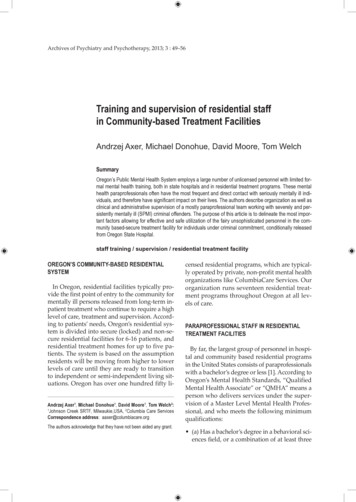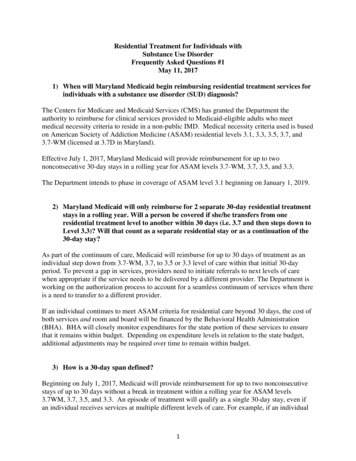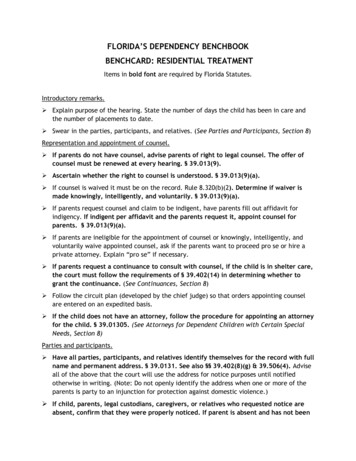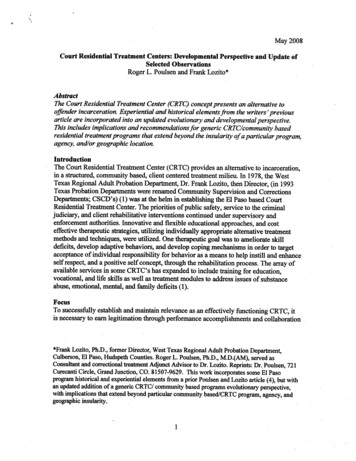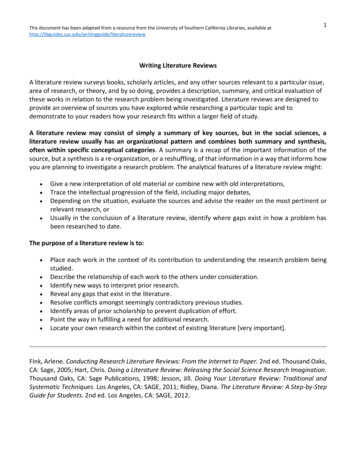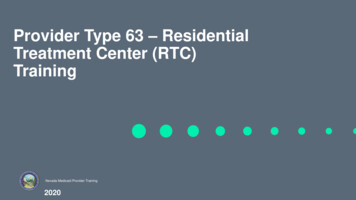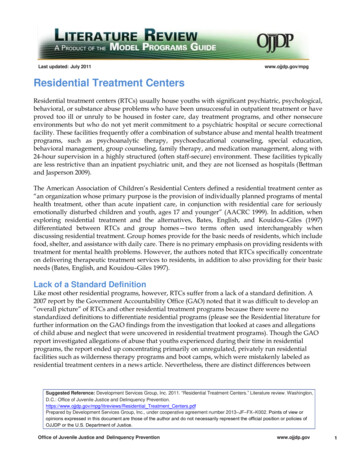
Transcription
Last updated: July 2011www.ojjdp.gov/mpgResidential Treatment CentersResidential treatment centers (RTCs) usually house youths with significant psychiatric, psychological,behavioral, or substance abuse problems who have been unsuccessful in outpatient treatment or haveproved too ill or unruly to be housed in foster care, day treatment programs, and other nonsecureenvironments but who do not yet merit commitment to a psychiatric hospital or secure correctionalfacility. These facilities frequently offer a combination of substance abuse and mental health treatmentprograms, such as psychoanalytic therapy, psychoeducational counseling, special education,behavioral management, group counseling, family therapy, and medication management, along with24-hour supervision in a highly structured (often staff-secure) environment. These facilities typicallyare less restrictive than an inpatient psychiatric unit, and they are not licensed as hospitals (Bettmanand Jasperson 2009).The American Association of Children’s Residential Centers defined a residential treatment center as“an organization whose primary purpose is the provision of individually planned programs of mentalhealth treatment, other than acute inpatient care, in conjunction with residential care for seriouslyemotionally disturbed children and youth, ages 17 and younger” (AACRC 1999). In addition, whenexploring residential treatment and the alternatives, Bates, English, and Kouidou–Giles (1997)differentiated between RTCs and group homes—two terms often used interchangeably whendiscussing residential treatment. Group homes provide for the basic needs of residents, which includefood, shelter, and assistance with daily care. There is no primary emphasis on providing residents withtreatment for mental health problems. However, the authors noted that RTCs specifically concentrateon delivering therapeutic treatment services to residents, in addition to also providing for their basicneeds (Bates, English, and Kouidou–Giles 1997).Lack of a Standard DefinitionLike most other residential programs, however, RTCs suffer from a lack of a standard definition. A2007 report by the Government Accountability Office (GAO) noted that it was difficult to develop an“overall picture” of RTCs and other residential treatment programs because there were nostandardized definitions to differentiate residential programs (please see the Residential literature forfurther information on the GAO findings from the investigation that looked at cases and allegationsof child abuse and neglect that were uncovered in residential treatment programs). Though the GAOreport investigated allegations of abuse that youths experienced during their time in residentialprograms, the report ended up concentrating primarily on unregulated, privately run residentialfacilities such as wilderness therapy programs and boot camps, which were mistakenly labeled asresidential treatment centers in a news article. Nevertheless, there are distinct differences betweenSuggested Reference: Development Services Group, Inc. 2011. “Residential Treatment Centers.” Literature review. Washington,D.C.: Office of Juvenile Justice and Delinquency sidential Treatment Centers.pdfPrepared by Development Services Group, Inc., under cooperative agreement number 2013–JF–FX–K002. Points of view oropinions expressed in this document are those of the author and do not necessarily represent the official position or policies ofOJJDP or the U.S. Department of Justice.Office of Juvenile Justice and Delinquency Preventionwww.ojjdp.gov1
these types of residential programs (Lee 2008).Changes in Program TheoryThere have been calls in the literature to re-envision the model of the RTC. McCurdy and McIntyre(2004), for example, argue that RTCs need to adopt a “stop-gap model,” the goals of which are tointerrupt the downward spiral of youth in crisis and prepare youth for reintegration. Chance andcolleagues (2010) likewise encourage a model that brings together short-term, intensive residentialtreatment with aftercare services delivered in the community’s continuum of care. Lyons andcolleagues (2009) similarly recognize the special importance of community resources, noting thatlength-of-stay decisions should be determined in part by what is available to the youth and familypostdischarge.Characteristics of RTCsThe Juvenile Residential Facility Census, a biennial survey conducted by the Office of Juvenile Justiceand Delinquency Prevention (OJJDP), found that more than 900 facilities identified themselves asresidential treatment centers. RTCs constituted 35 percent of all reporting facilities and held 32 percentof juvenile offenders in placement on the census date (Hockenberry, Sickmund, and Sladky 2009). RTCsand group homes outnumbered all other types of facilities included on the survey (though this findingmay be misleading, as residential facilities are asked to self-report which type of facility they are andthe survey does not provide definitions to differentiate between the various facility types listed,including RTCs, detention centers, training schools, group homes, ranch/wilderness camps, bootcamps, reception or diagnostic centers, and runaway and homeless shelters).The number of residents held in facilities that self-identified as RTCs varied. Only 18 percent of RTCsreported currently holding 10 or fewer residents. Most (57 percent) reported currently holding 11 to 50residents in the facility. About one third of RTCs reported being at their standard bed capacity; only 3percent reported being over capacity of their standard beds. Security features also varied across RTCs.Fewer than half (43 percent) reported using one or more confinement features, such as locked doors orgates, to restrict youth (Hockenberry, Sickmund, and Sladky 2009).The survey asked facilities about the counseling and therapy services that were provided to youth. Ofthe 919 self-identified RTCs, 532 (about 58 percent) reported providing counseling services to youth inresidence. Of those providing therapy, 89 percent provided individual therapy, 91 percent providedgroup therapy, and only half provided family therapy. In addition, of the 919 RTCs, 658 (about 72percent) reported providing therapy services. Ninety-three percent provided individual therapy, 92percent provided group therapy, and 58 percent provided family therapy. The survey did notdifferentiate between therapy and counseling services (Hockenberry, Sickmund, and Sladky 2009).In addition, the survey found the RTCs and group homes were more likely then other residentialplacements to have in-house mental health professionals who evaluate all youths for mental healthneeds. Seventy-three percent of RTCs reported having in-house mental health professional available toevaluate youths’ mental health needs (Hockenberry, Sickmund, and Sladky 2009).Variation in Treatment CentersThough there are some common characteristics among facilities, RTCs can dramatically differ onnumerous factors. For example, there are variations in staff education and qualifications, treatmentorganization, site theoretical orientation, and client psychopathology. In addition, individual andparental participation, family therapy involvement, vocational training components, and postdischargeOffice of Juvenile Justice and Delinquency Preventionwww.ojjdp.gov2
support can also vary among programs. For example, some residential treatment programs functionfrom an ecological perspective, addressing individual problems with youths and concentrating on theinteraction between youths and their environments. Other programs may take a therapeuticcommunity approach, addressing problem behaviors through peer influence. However, there is a lackof research that measures or examines the influence of these factors on the success of treatment, so itremains unclear what program elements are important and beneficial to the treatment process (Bettmanand Jasperson 2009).Target PopulationIn 2004, Federal funding supported the placement of 200,000 youths in government or privateresidential facilities, which include youths not involved in the juvenile justice system (GAO 2008b).Between 15 percent and 30 percent of youths in out-of-home care reside in RTCs (Whittaker 2004). TheSurvey of Youth in Residential Placement, another survey conducted by OJJDP, found that in 2003approximately 14,070 juveniles were in a residential treatment program, which includes RTCs andother types of residential programs (Sedlak and McPherson 2010). Youths in residential treatment madeup 14 percent of the total population of youths in placement.There appears to be a general acceptance that the youths being sent to RTCs present increasingly intenseand severe behavioral and emotional problems, academic problems, and substance use problems(Baker, Fulmore, and Collins 2008; Baker, Ashare, and Charvat 2009; Lyons et al. 2009). The 2000American Association of Children’s Residential Centers National Survey identified four main reasonsfor admission into an RTC: Severe emotional disturbanceAggressive/violent behaviorsFamily/school/community problemsAbuse (Foltz 2004)However, there is almost no research on the best target population for this type of facility and treatment.As Whittaker (2004) points out, because this treatment option is so expensive and radical, it must beused where it will be most effective. Mental health and substance abuse professionals have alsorepeatedly called for clearer admission criteria for RTCs, to avoid incarcerating youths in inappropriatesettings or with inappropriate and potentially dangerous peer groups.Outcome EvidenceAs with most treatment options where there is enormous diversity in the type and quality of servicesbeing offered, the literature regarding RTCs shows mixed results. Bettmann and Jasperson (2009)conducted a review of the outcome literature on adolescent residential treatment programs, includingRTCs. Examining 13 studies they found to fit their review criteria, they concluded that “the outcomeliterature of adolescent residential and inpatient treatment indicates that these therapeutic settings aresuccessful interventions for many clients” (2009, 174). However, they also observed several significantdeficits in the existing literature that limit any definitive conclusions about the effectiveness ofresidential treatment programs. They note that there is a lack of research that assesses the effectivenessof specific program elements; there is no consensus in the research on a definition of residentialtreatment and little agreement on what constitutes treatment success; insufficient details anddescriptions are provided in evaluation studies that look at the effectiveness of specific programs(making it difficult to replicate a particular treatment approach); and there is a need for outcomeresearch to examine the cultural sensitivity of child and adolescent residential treatment (Bettman andJasperson 2009). (See the Residential literature for further information on the limitations of research.)Office of Juvenile Justice and Delinquency Preventionwww.ojjdp.gov3
In addition to these limitations, many of the treatments and services, whether psychotropic orpsychosocial, delivered to youth in RTCs lack a foundation in research (Foltz 2004). For instance, Foltzcalls attention to the widespread use of medications that have largely been tested only on adultpopulations and are prescribed “off label” to adolescents in treatment. Few evidence-based practiceshave been tested in RTCs, because of, in part, issues such as the lack of fit between Medicaidreimbursement and many evidence-based interventions (Bright et al. 2010). Moreover, a lack of fundingcan mean that inadequate services are available. In a survey of New York State RTCs, it was found that,because of budget constraints, facilities were forced to hire staff with limited formal education (Baker,Fulmore, and Collins 2008).Some individual RTC programs have been evaluated and were shown to make a positive impact onyouth who received treatment services. For instance, the treatment model used by the Phoenix HouseAcademy (a therapeutic community for substance-abusing adolescents) was associated with betteroutcomes than the average expected outcome of alternative probation dispositions. In an evaluationusing a quasi-experimental nonequivalent comparison group design, the outcome results over a 1-yearfollow-up period for 125 youths who were enrolled in the Phoenix Academy were compared with 274control youths who received alternative probation dispositions. Compared with the control group,Phoenix House Academy youths had significantly better outcomes for most substance use andpsychological functioning outcomes (Morral, McCaffrey, and Ridgeway 2004). However, a recent studythat looked at a 7- to 8-year follow-up period found no evidence of positive effects on the outcomesmeasuring substance use problems, criminal activity, and psychological functioning. Although PhoenixAcademy appeared to have short-term effects, no long-term effects were evident.Moreover, an evaluation of the Mendota Juvenile Treatment Center (MJTC), an intensive treatmentprogram designed for serious and violent juvenile offenders, found positive effects on youths whoreceived treatment in the program. Caldwell and Rybroeck (2005) compared 101 youths who weretreated through MJTC with 147 youths who were briefly assessed at MJTC but who then returned to asecured correctional institution for the remainder of their sentence. Using propensity scores to controlfor nonrandom group assignment, the study found that youths treated at MJTC were only one sixth aslikely to commit felony violent offenses as the comparison group youths were. MJTC treatment, inaddition to reducing the number of youths involved in offending, increased the time youths were inthe community before they reoffended.Finally, the Residential Student Assistance Program (RSAP) was shown to make positive impacts onthe alcohol, marijuana, and tobacco use of youths. The program, which provides culturally sensitivealcohol and drug prevention and intervention services to mostly African American and Latino youth,was evaluated using a quasi-experimental design with two nonequivalent groups: the treatment group,consisting of 125 youths who participated in RSAP, and the control group, consisting of 211 youths whoeither chose not to participate in RSAP or participated in another residential facility that did not use theRSAP model (Morehouse and Tobler 2000). The results showed reductions in measures of alcohol,marijuana, and tobacco use for youths who participated in RSAP, compared with youths in the controlgroup.Alternatives to Residential PlacementCritics of residential placement often express concerns about decisions to remove youths from theirhomes and communities to treat them in settings such as RTCs. Some argue that placing youths withpsychiatric or behavioral problems together in a residential environment may cause more harm to anindividual’s treatment process. Youths may be traumatized by the experience of being removed fromOffice of Juvenile Justice and Delinquency Preventionwww.ojjdp.gov4
their home and placed in a residential program, hindering their chances of treatment success. Inaddition, the costs of placing youths in residential programs such as RTCs can be substantial to thejuvenile justice system (Bettman and Jasperson 2009). A report from the Justice Policy Institute (2009)estimates that reporting States spend an average of 7.1 million a day keeping youths in residentialfacilities. Thus, many jurisdictions across the country have implemented alternative options to secureresidential placements and confinement for youths who could be served better in community-basedtreatment programs, instead of receiving treatment in residential settings such as RTCs (though thesealternatives may not be appropriate for all youths).Alternatives to secure corrections or confinement, including residential placements, are specialprogramming approaches designed to prevent youths from being placed out of the home environmentfor any significant length of time. The concept follows from the premise that time spent in out-of-homeplacement may do more harm than good for these youths. Further, these alternatives give such youthsthe benefit of remaining in their communities with greater access to needed resources (i.e., necessarytreatment and medical services) without endangering the community and at much less expense thensecure residential placement (OJJDP 2001). In addition, the many problems associated with reentry areavoided because the youth is never entirely estranged from the community for a lengthy period of time.Finally, this approach keeps less serious or nonviolent offenders at home or in their home communities,thus increasing the availability of secure beds for the most serious and violent offenders (OJJDP 2001).There are several different types of secure confinement and placement alternatives, including homeconfinement or house arrest, day or evening reporting centers, shelter care, specialized foster care, andintensive supervision programs. Wraparound/case management is another program type designed tokeep youth at home and out of institutions or residential placements whenever possible. The strategyinvolves “wrapping” a comprehensive array of individualized services and support networks“around” young people, rather than forcing them to enroll in inflexible treatment programs. Many ofthe wraparound initiatives and programs that have been evaluated, including Wraparound Milwaukeeand Connections, have concentrated on youths with mental health needs. The research on theseprograms finds that youths who receive wraparound/case management services show improvementsin behavior and everyday functioning, as well as reduced risks of delinquency, compared with youthswho do not receive those services.Office of Juvenile Justice and Delinquency Preventionwww.ojjdp.gov5
References(AACRC) American Association of Residential Treatment Centers. 1999. Outcomes in Children’sResidential Treatment Centers: A National Survey. Washington, D.C.Baker, Amy J.L., Caryn Ashare, and Benjamin J. Charvat. 2009. “Substance Use and DependencyDisorders in Adolescent Girls in Group Living Programs: Prevalence and Associations WithMilieu Factors.” Residential Treatment for Children & Youth 26(1):42–57.Baker, Amy J.L., Darren Fulmore, and Julie Collins. 2008. “A Survey of Mental Health Service Provisionin New York State Residential Treatment Centers.” Residential Treatment for Children & Youth25(4):333–57.Bates, Brady C., Diana J. English, and Sophia Kouidou–Giles. 1997. “Residential Treatment and ItsAlternatives: A Review of the Literature.” Child & Youth Care Forum 26(1):7–51.Bettmann, Joanna E., and Rachael A. Jasperson. 2009. “Adolescents in Residential and InpatientTreatment: A Review of the Outcome Literature.” Child & Youth Care Forum 38(4):161–83.Bright, Charlotte Lyn, Ramesh Raghavan, Matthew D. Kliethermes, David Juedemann, and Jerry Dunn.2010. “Collaborative Implementation of a Sequenced Trauma-Focused Intervention for Youthin Residential Care.” Residential Treatment for Children & Youth 27(2):69–79.Caldwell, Michael F., and Gregory J. Van Rybroek. 2005. “Reducing Violence in Serious JuvenileOffenders Using Intensive Treatment.” International Journal of Law and Psychiatry 28:622–36.Chance, Sarah, Daren Dickson, Patricia Marrone Bennett, and Susan Stone. 2010. “Unlocking the Doors:How Fundamental Changes in Residential Care Can Improve the Ways We Help Children andFamilies.” Residential Treatment for Children & Youth 27(2):127–48.Edelen, Maria Orlando, Mary Ellen Slaughter, Daniel F. McCaffrey, Kirsten Becker, and Andrew R.Morral. 2010. “Long-Term Effect of Community-Based Treatment: Evidence From theAdolescent Outcomes Project.” Drug and Alcohol Dependence 107(1):62–68.Federal Trade Commission. 2008. FTC Facts for Consumers: Considering a Private Residential TreatmentProgram for a Troubled Teen? Questions for Parents and Guardians to Ask. Washington, D.C.:Division of Consumer and Business Education, Bureau of Consumer Protection, Federal TradeCommission.Foltz, Robert. 2004. “The Efficacy of Residential Treatment: An Overview of the Evidence.” ResidentialTreatment for Children & Youth 22(2):1–19.(GAO) Government Accountability Office. 2007. “Residential Treatment Programs: ConcernsRegarding Abuse and Death in Certain Programs for Troubled Youth.” Testimony Before theCommittee of Education and Labor, U.S. House of Representatives. Washington, D.C.(GAO) Government Accountability Office. 2008a. “Residential Programs: Selected Cases of Death,Abuse, and Deceptive Marketing.” Testimony Before the Committee of Education and Labor,U.S. House of Representatives. Washington, D.C.(GAO) Government Accountability Office. 2008b. “Residential Facilities: State and Federal OversightGaps May Increase Risk to Youth Well-Being.” Testimony Before the Committee of Educationand Labor, U.S. House of Representatives. Washington, D.C.Hockenberry, Sarah, Melissa Sickmund, and Anthony Sladky. 2009. Juvenile Residential Facility Census,2006: Selected Findings. Washington, D.C.: U.S. Department of Justice, Office of Justice Programs,Bureau of Justice Statistics.Justice Policy Institute. 2009. The Costs of Confinement: Why Good Juvenile Justice Policies Make Good FiscalSense. Washington, D.C.Lee, Bethany R. 2008. “Defining Residential Treatment.” Journal of Child and Family Studies 17(5):689–92.Lyons, John S., Heather Woltman, Zoran Martinovich, and Brian Hancock. 2009. “An OutcomesPerspective of the Role of Residential Treatment in the System of Care.” Residential Treatment forChildren & Youth 26(2):71–91.Office of Juvenile Justice and Delinquency Preventionwww.ojjdp.gov6
McCurdy, Barry L., and E.K. McIntyre. 2004. “‘And What About Residential.?’ ReconceptualizingResidential Treatment as a Stop-Gap Service for Youth With Emotional and BehavioralDisorders.” Behavioral Interventions 19(3):137–58.Morehouse, Ellen R., and Nancy S. Tobler. 2000. “Preventing and Reducing Substance Use AmongInstitutionalized Adolescents.” Adolescence 35(137):1–28.Morral, Andrew R., Daniel F. McCaffrey, and Greg Ridgeway. 2004. “Effectiveness of CommunityBased Treatment for Substance Abusing Adolescents: 12-Month Outcomes From a Case-ControlEvaluation of a Phoenix Academy.” Psychology of Addictive Behaviors 18(3):257–68.(OJJDP) Office of Juvenile Justice and Delinquency Prevention. 2001 .Disproportionate MinorityConfinement Technical Assistance Manual (Second Edition). Washington, DC: U.S. Department ofJustice, Office of Justice Programs, Office of Juvenile Justice and Delinquency Prevention.Pavkov, Thomas W., Sesen Negash, Ira S. Lourie, and Richard W. Hug. 2010. “Critical Failures in aRegional Network of Residential Treatment Facilities.” American Journal of Orthopsychiatry80(2):151–59.Sedlak, Andrea J., and Karla S. McPherson. 2010. Conditions of Confinement: Findings From the Survey ofYouth in Residential Placement. Washington, D.C.: U.S. Department of Justice, Office of JusticePrograms, Bureau of Justice Statistics.Whittaker, James K. 2004. “The Reinvention of Residential Treatment: An Agenda for Research andPractice.” Child and Adolescent Psychiatric Clinics of North America 13:267–78.Office of Juvenile Justice and Delinquency Preventionwww.ojjdp.gov7
The American Association of Children's Residential Centers defined a residential treatment center as "an organization whose primary purpose is the provision of individually planned programs of mental health treatment, other than acute inpatient care, in conjunction with residential care for seriously
